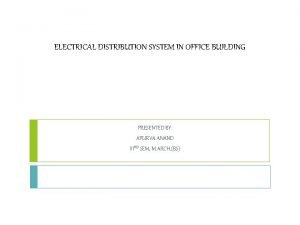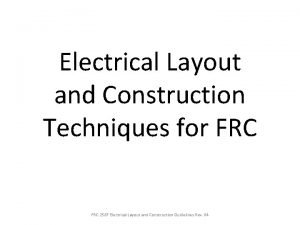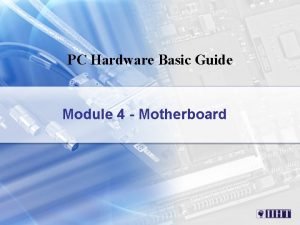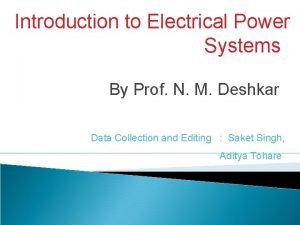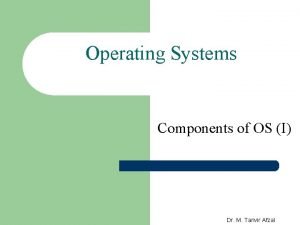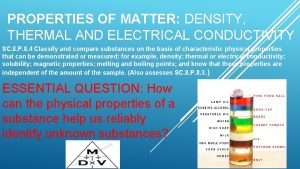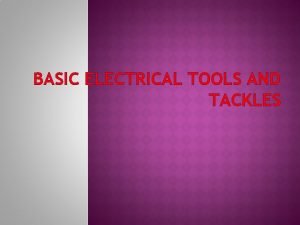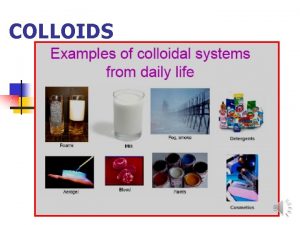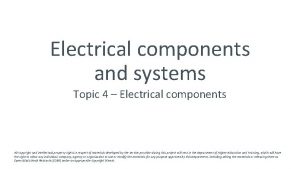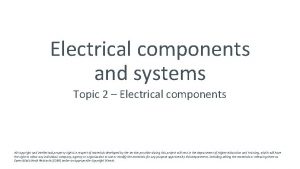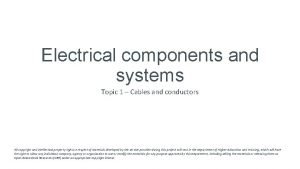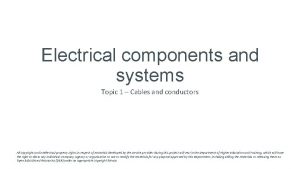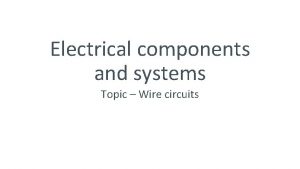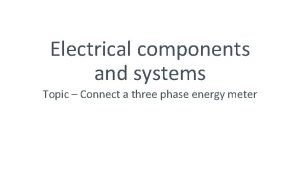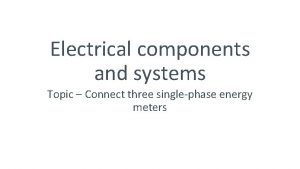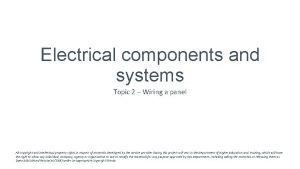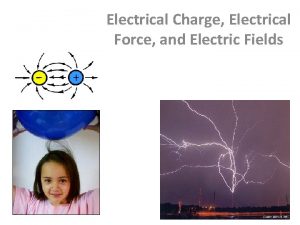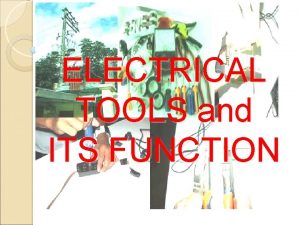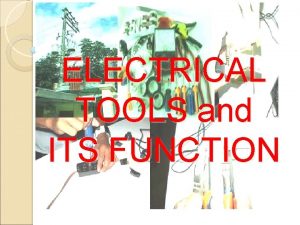Electrical components and systems Topic 3 Practising with






































- Slides: 38

Electrical components and systems Topic 3 – Practising with stove switches All copyright and intellectual property rights in respect of materials developed by the service provider during this project will vest in the Department of Higher Education and Training, which will have the right to allow any individual, company, agency or organisation to use or modify the materials for any purpose approved by this Department, including selling the materials or releasing them as Open Educational Resources (OER) under an appropriate copyright license.

Assumed prior learning • Wiring of premises • Cables and conductors • Circuit diagrams

Practising with stove switches Unit 2

In this lesson you will learn how to: • wire a three-heat stove switch • wire a five-heat stove switch • wire thermostatic control switches

Before wiring any switches… SAFETY FIRST !

From charcoal to induction Metal stove’s were first used in the 18 th century, the fuel burning stove is the most basic design. Modern cooking appliances make use of gas and electricity. The first electric stoves used heating elements made of high-resistance metal to produce heat.

Four position, three-heat switch These switches can still be found in use today but very rarely. It uses a combination of connections to control the heat of the stove plate.

How do we get three levels of heat on a 3 -heat switch? To get three levels of heat, two resistance of equal value is used. The resistances are connected either (i) in series, (ii) using one resistance only, (iii) using two resistances in parallel. We will explain this concept further using the example below. EXAMPLE

How the 3 -heat switch works A four position, three-heat stove switch is designed to operate a stove plate consisting of two separate elements. One end of each element being connected as a common point. IN SERIES ONE RESISTANCE ONLY IN PARALLEL

The switching position diagrams To determine the switching position on the four position three-heat stove switch: • Make a sketch of the terminals • Draw a diagram of the switch terminals • Use a megger or multimeter and test all the terminals Vid 01 screenshot

After watching video 1 answer the questions that follow based on circuit diagrams of a four-position, three-heat stove switch.

Question 1 Match the Circuit diagram shown with the position the three-heat stove switch is in. a) b) c) d) Off position Low position Medium position High position

Question 2 Match the Circuit diagram shown with the position the three-heat stove switch is in. a) b) c) d) Off position Low position Medium position High position

Question 3 Match the Circuit diagram shown with the position the three-heat stove switch is in. a) b) c) d) Off position Low position Medium position High position

Five-heat stove switch To achieve five levels of heat on a 5 -heat, six position stove switch, three resistances of equal value are used. The 5 -heat switch is similar to the 3 -heat, except that there is an extra high level where three elements are in parallel and an extra low one where three elements are in series.

Five-heat, stove switching arrangement The five different heats are obtained by the following switching arrangements: First position – three in series Second position – two in series Fourth position – two in parallel Third position – one in circuit Fifth position – three in parallel

Exercise Try this by yourself: Assume that each resistance on a five-heat switch has a value of 96Ω. Calculate the current in each switching position, if the supply voltage is 220 V.

Five-heat, stove switching positions To determine the switching positions on the six position five-heat stove switch: • Make a sketch of the terminals • Draw a diagram of the switch terminals • Use a megger or multimeter and test between all terminals Vid 02 screenshot

After watching video 2 answer the questions that follow based on circuit diagrams of a six-position, five-heat stove switch.

Question 1 Match the Circuit diagram shown with the position the five-heat stove switch is in. a) First position b) Second position c) Fourth position d) Fifth position

Question 2 Match the Circuit diagram shown with the position the five-heat stove switch is in. a) First position b) Second position c) Fourth position d) Off position

Question 3 Match the Circuit diagram shown with the position the five-heat stove switch is in. a) First position b) Second position c) Fourth position d) Fifth position

Thermostatic control switch A thermostat is a device used to keep temperature steady in most heating appliances. It acts as a switch, which is operated by the application of heat.

How does a bi-metal thermostat work? There are three parts to thermostat control; a small heater element, bi-metallic strip and an adjustment mechanism. Click on figure 1 to learn more

How does the oven thermostat work? The oven switch connects both the top and the bottom elements of the oven. The temperature of the oven is usually controlled by a bellows type thermostat. Click on figure 2 to learn more

Exploring the Simmerstat The thermostatic control switch for stove plates is sometimes known as a “simmerstat”, energy regulator or infinite switch. It operates on the same principle as the bi-metal thermostat and allows variable power output of the heating element. Click on figure 3 to learn more

Now that you’ve learnt how the different types of thermostats operate answer the questions that follow to test your understanding of this topic.

Question 1 What type of electrical equipment would you use to control the temperature in a geyser? a) b) c) d) Time switch Pressure switch Thermostat Thermometer

Question 2 What type of thermostat is normally used to control an oven? a) b) c) d) Bi-metal Simmerstat Bellows Capillary tube

Question 3 What is thermostat control switch for stove plates also known as? a) b) c) d) Bi-metal Simmerstat Bellows Capillary tube

Question 4 Label the parts of the oven thermostat

Let’s review: In this lesson we have covered: üThree-heat, four-position switches and it circuit diagram. üFive-heat, six-position switches and its circuit diagram. üTypes of thermostats used in heating appliances. üCircuit diagrams of thermostatic control switches. Make sure you have a complete understanding of all the work covered here before you start the next unit.

Video brief - Vid 01 Video of expert presenter explaining how to determine the switching position on the four position three-heat stove switch Voice over Remember you must isolate, lock out and test before commencing electrical work and Strictly adhere to the SANS wiring code. Wiring diagrams of the circuits must be drawn correctly and in accordance with the manufacturer’s markings; 1) The physical wiring of the circuits must be in accordance with the SANS Code of Practice for the Wiring of Premises, and the standards learnt in the unit on panel wiring; 2) All metal parts must be earthed; 3) The switch must operate correctly in all positions; 4) All the relevant safety precautions must be observed during the task. To determine the switching position on the four position three-heat stove switch, proceed as follows: Make a sketch of the terminals on the three-heat stove switch as viewed from the rear. (Fig. 2). Draw a diagram of the switch terminals in their four respective positions, to indicate the switch bridging. Image

Video brief - Vid 01 contin. Video of expert presenter explaining how to determine the switching position on the four position three-heat stove switch Voice over Image Use a megger or multimeter and test between all the terminals in each position. Draw in all the bridge positions on the diagram as follows: In off position (Presenter to explain) In low position (Presenter to explain) In medium position (presenter to explain) In high position (presenter to explain) From the above you can now determine which are your LIVE, NEUTRAL, COMMON and OTHER terminals. • It can be seen that No. 1 is the common terminal for three ON positions, therefore No. 1 is the live incoming terminal. • It is obvious that the LIVE and NEUTRAL should not be bridged (short-circuited) in any position. Therefore, No. 2 is the NEUTRAL incoming terminal. • In the MEDIUM position there is a common point to the two elements. Because the NEUTRAL is connected permanently to one end of an element it can be assumed that in the medium position the LIVE will bridge with a common point of one of the two elements. In this case it is No. 3 on the switch. • There is only one terminal remaining (No. 4) and this is called the OTHER terminal. Same image as above

Video brief - Vid 01 contin. Video of expert presenter explaining how to determine the switching position on the four position three-heat stove switch Voice over Some of these switches have an extra contact at the back for a pilot light. As soon as the switch is switched on low, medium or high, the pilot light comes on, showing that the switch is on. Circuit diagrams for three-heat operation: These are shown in Fig. 3, 4, 5 and 6 for different positions. (a) Off position (Fig. 3) (b) Low position (Fig. 4) (c) Medium position (Fig. 5) (d) High position (Fig. 6) Practice drawing these wiring diagrams before attempting the self-test. The idea is not to memorise them, but to understand them. Image

Video brief - Vid 02 Video of expert presenter explaining how to determine the switching position on the six position five-heat stove switch Voice over Remember you must isolate, lock out and test before commencing electrical work and Strictly adhere to the SANS wiring code. Wiring diagrams of the circuits must be drawn correctly and in accordance with the manufacturer’s markings; 1) The physical wiring of the circuits must be in accordance with the SANS Code of Practice for the Wiring of Premises, and the standards learnt in the unit on panel wiring; 2) All metal parts must be earthed; 3) The switch must operate correctly in all positions; 4) All the relevant safety precautions must be observed during the task. To determine the switching positions on the six position five-heat stove switch Make a sketch of the terminals on a five-heat stove switch as viewed from the rear. (Fig. 1). Draw a diagram of the switch terminals in their five respective positions, to indicate the switch bridging as shown below. Image

Video brief - Vid 02 contin. Video of expert presenter explaining how to determine the switching position on the six position five-heat stove switch Voice over Image Use a megger or multimeter and test between all terminals in each position. Draw in all the bridge positions on the diagram below as follows: In off position (Presenter to explain) In position 1 (Presenter to explain) In position 2 (presenter to explain) In position 3 (presenter to explain) In position 4 (Presenter to explain) In position 5 (presenter to explain) From the drawing the live, neutral and other terminals can be determined. In the above it can be seen that No. 1 is the common terminal for all five “ON” positions. Therefore No. 1 is the live incoming terminal. The live and neutral are never bridged in any position. Therefore No. 2 is the neutral Same as above

Video brief - Vid 02 contin. Video of expert presenter explaining how to determine the switching position on the six position five-heat stove switch Voice over These are the Circuit diagrams for a five-heat stove switch. (presenter to go over and explain each in turn) (i) Fig 2 - Off position (ii) Fig 3 - Position 1 (iii) Fig 4 - Position 2 (iv) Fig 5 - Position 3 (v) Fig. 6 - Position 4 (vi) Fig. 7 - Position 5 Image
 Lupanga practising secondary school
Lupanga practising secondary school Practising reading
Practising reading Broad and specific topic examples
Broad and specific topic examples Narrow down the topic
Narrow down the topic Vertical system
Vertical system Aircraft electrical components
Aircraft electrical components Frc control system layout
Frc control system layout Free enterprise system def
Free enterprise system def Module 4 topic 2 components of the space management system
Module 4 topic 2 components of the space management system What is irrelevant sentences
What is irrelevant sentences Mathematical modelling of mechanical systems examples
Mathematical modelling of mechanical systems examples Introduction to electrical power systems
Introduction to electrical power systems One electrical systems
One electrical systems Module 10 topic 2 vehicle malfunctions
Module 10 topic 2 vehicle malfunctions Decision support systems and intelligent systems
Decision support systems and intelligent systems Components of operating systems
Components of operating systems Operating system components
Operating system components Components of an operating system
Components of an operating system Introduction to business information systems
Introduction to business information systems Media systems definition
Media systems definition Cross section of antilock braking system components/systems
Cross section of antilock braking system components/systems Components of operating system
Components of operating system 5 components of information system
5 components of information system Computer systems components
Computer systems components Principles of complex systems for systems engineering
Principles of complex systems for systems engineering Embedded systems vs cyber physical systems
Embedded systems vs cyber physical systems Engineering elegant systems: theory of systems engineering
Engineering elegant systems: theory of systems engineering What are the materials needed in making
What are the materials needed in making Electrical conductivity property of matter
Electrical conductivity property of matter Klipsch school of electrical and computer engineering
Klipsch school of electrical and computer engineering Cleat wiring image
Cleat wiring image Electrical trade theory
Electrical trade theory Principles of wires
Principles of wires Raceways electrical
Raceways electrical Multitester
Multitester Electrical synapse vs chemical synapse
Electrical synapse vs chemical synapse 26109 conductors and cables
26109 conductors and cables Discuss the optical and electrical properties of colloids
Discuss the optical and electrical properties of colloids Base electrical conductivity
Base electrical conductivity




